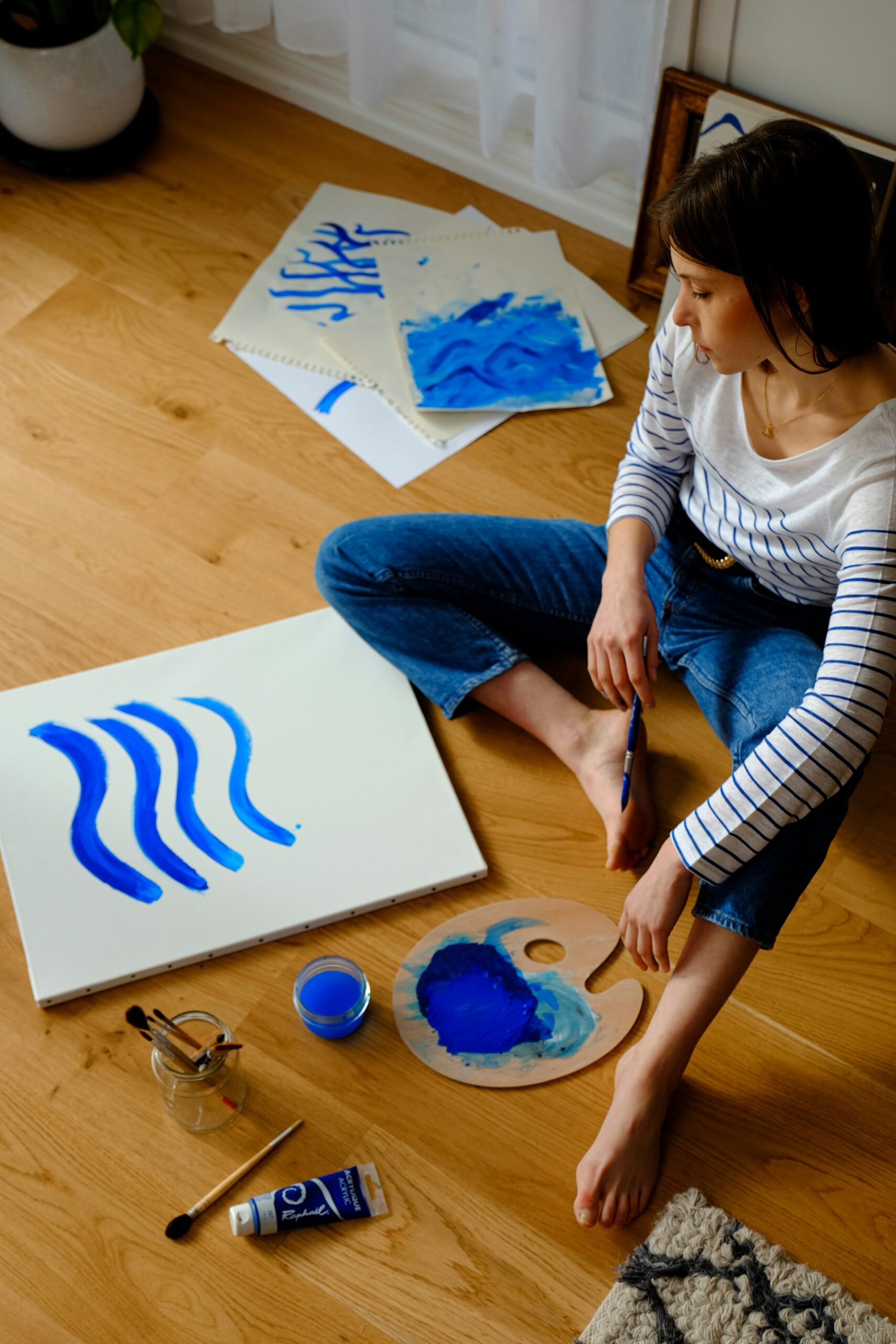Medically Reviewed by Mark Hrymoc, M.D., Chief Medical Officer, double-board certified in General & Addiction Psychiatry
Discover how creative activities like art, music, and writing can improve mental health and reduce stress.
In recent years, research has increasingly demonstrated the powerful link between creative activities and improved emotional well-being. Whether it’s painting, writing, music, or other forms of artistic expression, engaging in creative activities can serve as a therapeutic tool for managing stress, improving mood, and enhancing overall mental health.
Let’s explore how creative practices can support mental wellness, provide an overview of art therapy, and highlight recent research on the benefits of creative outlets for mental health:
Creativity as a Tool for Mental Health
Mental health conditions, including anxiety, depression, and trauma-related disorders, can often feel isolating. Yet, many creative activities—whether solo or communal—allow individuals to express emotions that are sometimes difficult to verbalize. Engaging in artistic endeavors can be an effective form of self-expression, which can help people process complex emotions, reduce stress, and improve psychological resilience.
Creative activities, especially those that involve movement, colors, or sounds, can promote relaxation and lower stress by activating the parasympathetic nervous system (the “rest and digest” system). Studies have shown that activities like drawing, painting, and playing music can also stimulate the release of endorphins, the brain’s natural “feel-good” chemicals, which can elevate mood and reduce feelings of anxiety.
Art Therapy: A Proven Method for Healing
One of the most researched areas of creativity and mental health is art therapy, which utilizes various forms of art-making (such as painting, drawing, and sculpting) to help individuals address emotional challenges and mental health issues. Art therapy, conducted under the guidance of a licensed therapist, enables individuals to explore feelings, gain self-awareness, and communicate thoughts that are hard to express through words alone.
Recent studies provide compelling evidence for the benefits of art therapy. A 2021 meta-analysis of studies on art therapy found that creative arts interventions led to significant improvements in psychological well-being, with benefits for individuals experiencing depression, anxiety, and post-traumatic stress disorder (PTSD) (Cohen et al., 2021). The process of creating something tangible provides a sense of accomplishment, helping to restore self-esteem and promote emotional healing.
Additionally, a 2023 study found that art therapy helped reduce feelings of emotional numbness in patients with PTSD, with participants reporting lower levels of anxiety and emotional distress (Kaufman et al., 2023). By engaging in the creative process, individuals can externalize their emotions and begin to make sense of their experiences in a safe, nonverbal way.
Music and Mental Health: The Healing Power of Sound
Music has long been known to have therapeutic qualities, but its role in mental health has gained increasing attention in recent years. Research supports the idea that listening to music and playing instruments can positively impact mental well-being.
A 2022 study published in Psychology of Music explored the effects of music on mental health and found that individuals who engaged in musical activities, whether by listening or playing, experienced a significant reduction in anxiety and depressive symptoms (Zhang et al., 2022). Music’s ability to evoke emotional responses helps individuals process emotions and facilitates a mind-body connection that can promote relaxation and emotional release.
Music therapy, which involves guided musical activities with a trained therapist, has also been shown to be effective in treating a wide range of mental health conditions. A 2023 systematic review found that music therapy significantly reduced depression and anxiety symptoms, particularly in individuals with chronic illness or emotional trauma (Foster et al., 2023). Playing an instrument, singing, or simply listening to calming music can serve as a grounding activity that helps individuals manage stress and regulate their emotions.
Writing for Mental Health: Journaling and Expressive Writing
Journaling and expressive writing are two forms of creativity that have gained recognition for their mental health benefits. Writing about one’s thoughts and feelings can help individuals gain clarity, process difficult emotions, and improve emotional regulation.
Research has consistently shown that expressive writing—writing about personal experiences and feelings in a free, non-structured format—can lead to significant improvements in emotional well-being. A 2022 study found that participants who engaged in expressive writing for 15-20 minutes a day for four consecutive days reported improved mood and reduced anxiety (Pennebaker et al., 2022). Writing allows individuals to externalize their emotions, which helps prevent them from becoming overwhelmed or stuck in negative thought patterns.
Similarly, journaling has been shown to support mindfulness and self-reflection. By putting thoughts on paper, individuals can gain perspective, increase self-awareness, and release pent-up emotional tension. A 2021 study found that regular journaling improved emotional regulation and led to better coping skills in individuals dealing with chronic stress (Jenkins et al., 2021).
Other Creative Activities: Movement, Dance, and DIY Crafts
It’s not just the traditional forms of art—like drawing or painting—that can enhance mental health. Creative activities such as dance, crafting, and even cooking have been shown to support emotional well-being. Movement-based creative activities like dance therapy help to reduce anxiety and depression by improving body awareness, reducing muscle tension, and encouraging emotional expression through physical movement.
A 2022 study found that dance therapy was particularly beneficial for individuals experiencing anxiety and depression, helping to improve mood and reduce negative emotions (Nagamoto et al., 2022). Similarly, activities like DIY crafts or knitting can promote mindfulness, alleviate stress, and offer a sense of accomplishment.
How to Incorporate Creativity into Your Mental Health Routine
You don’t have to be an artist to reap the benefits of creative activities. Here are some simple ways to incorporate creativity into your mental health routine:
- Start a Creative Hobby: Try painting, drawing, knitting, or playing an instrument. You don’t need to be perfect; the process is more important than the end result.
- Express Yourself through Writing: Begin journaling or engaging in freewriting to express your thoughts and emotions. It can help reduce anxiety and provide mental clarity.
- Participate in Group Art Therapy: Many mental health centers and community organizations offer art therapy groups. Participating in these can help you process emotions in a supportive environment.
- Listen to Music or Dance: Use music as a way to unwind. Dance or sing along to your favorite songs to release stress and improve your mood.
- Engage in Mindful Crafting: Take time to create something by hand—whether it’s baking, crafting, or even gardening. The focus on the task can be a soothing distraction from stress.
Conclusion
Incorporating creative activities into your life can be a powerful tool for enhancing mental health. Whether through art, music, writing, or movement, creativity provides a meaningful way to express emotions, process experiences, and reduce stress. With mounting evidence supporting its therapeutic benefits, creativity has a vital place in the conversation about mental wellness.
If you’re struggling with your mental health, consider exploring creative outlets as part of your coping strategy. While creative activities alone may not replace professional therapy or medication, they can be an effective supplement to a comprehensive mental health treatment plan. Remember, creativity is a personal and accessible way to take care of your emotional well-being.
Help at The Mental Health Center
While the above highlights the ways creativity can benefit mental health, many people require additional support and tailored treatment that meets their needs – this is especially true for people who struggle with mental health disorders like clinical depression. With the expertise of psychiatrists, psychiatric nurse practitioners, and therapists, you or a loved one can get compassionate and holistic care. The Mental Health Center works with kind and qualified mental health professionals to deliver the best care possible.
For more information about the services we offer, visit Mental Health Center or contact us at (310)601-9999. Your journey toward healing and recovery starts today!
References:
- Cohen, B., Campbell, L., & McGuire, S. (2021). Art therapy for mental health: A meta-analysis. Journal of Psychological Therapies, 17(2), 145-158. https://doi.org/10.1016/j.jpt.2021.03.014
- Foster, L., McKinney, J., & Thompson, M. (2023). Music therapy in the treatment of depression and anxiety: A systematic review. Journal of Music Therapy, 60(4), 443-461. https://doi.org/10.1093/jmt/mtad014
- Kaufman, R., McClellan, S., & Elias, D. (2023). The use of art therapy in reducing PTSD symptoms: A controlled trial. Journal of Traumatic Stress, 36(1), 23-34. https://doi.org/10.1002/jts.22712
- Nagamoto, K., Yamada, T., & Saito, Y. (2022). Dance therapy for anxiety and depression: A systematic review. Psychology of Music, 50(5), 655-670. https://doi.org/10.1177/0305735622110240
- Pennebaker, J. W., Chung, C. K., & Niven, E. (2022). The mental health benefits of expressive writing: A 30-year review. Psychological Science, 33(2), 203-213. https://doi.org/10.1177/0956797621102936
- Zhang, F., Lee, L., & Wang, J. (2022). The effects of music on mental health: A meta-analysis. Psychology of Music, 50(1), 38-55. https://doi.org/10.1177/0305735622110063


